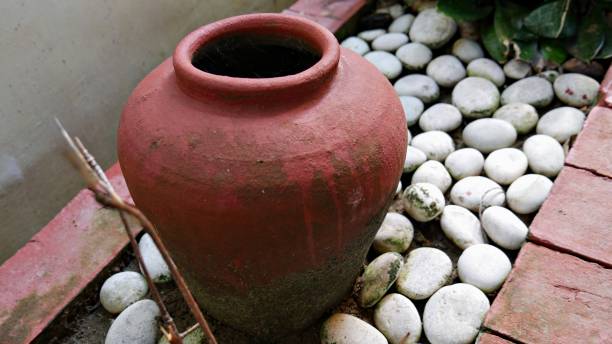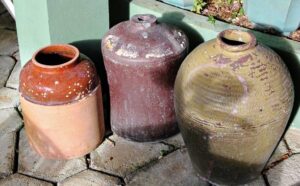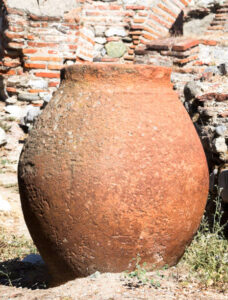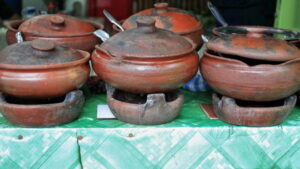Discovering the Magic of the Banga: A Journey Through Filipino Clay Pots

The word “banga” brings back memories of traditional Filipino cooking and culture. This special term refers to a type of clay pot used in Filipino households for centuries. A banga is not just any pot; it’s a symbol of the rich heritage and culinary practices of the Philippines.
When you look at a banga, you see more than just a vessel for cooking. You see a piece of history, a link to the past, and a connection to the Filipino way of life. These pots, often made from sturdy clay, were used for everything from storing food to cooking delicious traditional dishes. Let’s dive into the world of the banga and explore its fascinating story.
What is a Banga? Understanding This Filipino Clay Pot
A banga is a special type of clay pot used in Filipino kitchens. This traditional pot is made from durable clay and is designed for cooking and storing food. It has a unique shape that helps in slow cooking, which makes dishes taste amazing.
You might see a banga in many Filipino households. They are often used to cook rice, stews, and even ferment sauces. This pot is a key part of Filipino culture and history. It has been used for generations to prepare traditional dishes.
Traditionally, a banga is made by hand, which makes each one special. The craftsmanship involved in making it shows the skill of Filipino potters. This traditional pot is not just for cooking; it’s also a symbol of Filipino heritage.
Using it can make your cooking experience unique. Its traditional design and method of cooking give food a special flavor that’s hard to replicate with modern cookware. If you ever get a chance to use one, you’ll understand why it’s so cherished.
The History of the Banga: A Journey Through Time
The history of the banga dates back many centuries in the Philippines. This clay pot has been used by Filipino families for generations. It’s more than just a cooking tool; it’s a piece of history that tells the story of Filipino life.
Originally, bangas were crafted by hand using local clay. Potters would shape the clay into pots and then fire them in traditional kilns. These pots were used to store food and cook meals, becoming an essential part of daily life.
As time went on, the banga evolved but remained an important part of Filipino culture. Today, while modern cooking tools are available, many people still use bangas to preserve traditional cooking methods. This helps keep the rich history of Filipino cooking alive.
In museums and historical sites, you can find ancient bangas that showcase their historical significance. They provide a glimpse into the past and help us appreciate how cooking and pottery have developed over time.
Why the Banga is So Important in Filipino Culture
The banga holds a special place in Filipino culture for several reasons. First, it represents the rich culinary traditions of the Philippines. Many traditional dishes are cooked in a banga, which adds unique flavors to the food.
In Filipino households, the banga is more than just a cooking pot. It’s a symbol of family and community gatherings. Cooking with a banga often brings people together, making meals more meaningful and enjoyable.
Moreover, the craftsmanship involved in making a banga reflects the skill and artistry of Filipino potters. Each pot is handmade with care, and this craftsmanship is celebrated as part of Filipino heritage. The banga is a testament to the artistry and traditions passed down through generations.
Finally, the banga is used in many cultural and festive occasions. It’s common to see these pots during Filipino celebrations, where they are used to prepare traditional dishes. This helps maintain a connection to cultural roots and practices.
How to Use a Banga: Tips and Tricks
Using a banga can be a fun and rewarding experience. First, it’s important to season the pot before cooking. This involves heating the pot and coating it with oil to prevent food from sticking and to enhance its flavor.
When cooking with it, use low to medium heat. The clay pot is designed to distribute heat evenly, which makes it perfect for slow cooking. This method helps in bringing out the best flavors in your dishes.
Always make sure to keep the banga clean and dry after use. Avoid sudden temperature changes as it can crack the pot. A gentle hand wash and proper drying will keep the banga in good condition for years to come.
If you’re new to using a banga, start with simple recipes. Traditional Filipino dishes like adobo or sinigang are great choices. This will help you get used to cooking with the pot and appreciate its unique benefits.
Where to Find a Banga: Locating These Special Pots
Finding a banga can be a bit of a treasure hunt. These special pots are often sold in Filipino markets and specialty stores that focus on traditional cookware. They can also be found in regions with a large Filipino community.
Online stores and marketplaces may have bangas available for purchase. Search for Filipino or Asian cookware shops that offer traditional items. Websites that specialize in cultural and artisanal goods often carry these unique pots.
Another great place to look is at cultural festivals or craft fairs. These events sometimes feature vendors who sell handmade Filipino items, including bangas. You might find a beautiful, handcrafted banga that suits your needs.
If you’re visiting the Philippines, local markets and pottery shops are excellent places to find a banga. Exploring these markets can also give you a chance to learn more about traditional Filipino pottery and culture.
The Different Types of Banga and Their Uses
Bangas come in various shapes and sizes, each designed for different purposes. Some are large and round, ideal for cooking stews and soups. Others are smaller and more narrow, perfect for storing sauces and condiments.
The classic banga, with its wide mouth and sturdy base, is great for cooking rice and slow-cooked dishes. Its shape allows for even heat distribution, which enhances the flavors of your food.
There are also specialized bangas used for fermenting sauces like bagoong. These pots have specific features that aid in fermentation, making them essential for traditional Filipino recipes.
Understanding the different types of bangas can help you choose the right one for your cooking needs. Each type offers unique benefits and adds authenticity to your Filipino culinary experience.
How to Care for Your Banga: Cleaning and Maintenance
Caring for a banga is essential to keep it in good condition. After using the pot, let it cool down before washing. Sudden temperature changes can damage the clay, so a gentle approach is best.
Wash your banga with warm water and a soft sponge. Avoid using harsh chemicals or scrubbing too hard, as this can harm the pot’s surface. If needed, you can use a mild soap to clean the inside.
After washing, thoroughly dry the it before storing it. Make sure it’s completely dry to prevent mold or mildew from forming. Store the pot in a dry, cool place to keep it in top shape.
Periodically check your banga for any cracks or damage. If you find any, avoid using the pot for cooking until it’s repaired. Proper care will ensure your banga lasts for many years and continues to be a cherished part of your kitchen.
Cooking with a Banga: Traditional Filipino Recipes
Cooking with a banga brings a unique flavor to traditional Filipino recipes. Dishes like adobo and sinigang benefit from the even heat distribution of the clay pot. The slow cooking process helps in developing rich and deep flavors.
Adobo, a popular Filipino dish, is perfect for a banga. The pot’s ability to maintain a steady temperature allows the meat and spices to blend beautifully. The result is a flavorful, tender adobo that’s sure to impress.
Sinigang, a sour soup, also shines when cooked in a banga. The pot enhances the tangy flavor of the tamarind and the freshness of the vegetables. Cooking in a banga gives the soup a comforting, homemade taste.
Experimenting with other Filipino recipes in your banga can be a rewarding experience. Each dish cooked in this traditional pot will have a unique taste that reflects the rich heritage of Filipino cooking.

The Craftsmanship Behind the Banga: Making Clay Pots
Making it involves a skilled process that showcases Filipino craftsmanship. Potters start by selecting the right clay, which is then shaped into the desired form. This step requires careful attention to detail to ensure the pot’s durability.
Once shaped, the banga is dried and fired in a kiln. The firing process hardens the clay and gives the pot its distinctive color and texture. This traditional method of firing is essential to the pot’s quality and strength.
The artistry involved in creating a banga is a testament to the potter’s skill. Each pot is unique, reflecting the individual touches and techniques of the craftsman. This craftsmanship is an important part of Filipino cultural heritage.
Owning a handmade banga means you have a piece of art and tradition in your kitchen. The careful work that goes into each pot makes it not just a cooking tool, but a cherished item that tells a story of Filipino artistry.
Why the Banga is Perfect for Outdoor Cooking
The banga is an excellent choice for outdoor cooking due to its heat retention properties. Its thick, clay walls help keep the heat steady, making it ideal for grilling or slow-cooking meals outdoors.
Outdoor cooking with a banga can enhance the flavors of your food. The pot’s ability to evenly distribute heat ensures that dishes are cooked thoroughly, resulting in a delicious and satisfying meal.
Moreover, using a banga outside adds a touch of tradition to your cooking. It connects you to Filipino culinary practices while enjoying a meal in the open air. This experience can be both enjoyable and educational.
To make the most of your banga for outdoor cooking, ensure it’s properly seasoned and handled with care. With the right preparation, your outdoor meals will benefit from the unique qualities of this traditional pot.
Banga vs. Other Clay Pots: What Makes It Unique?
The banga stands out among other clay pots due to its specific design and use. Unlike some clay pots, the banga has a distinctive shape that makes it ideal for slow cooking and storing food. Its design enhances the flavors of the dishes prepared in it.
Other clay pots may have different shapes or sizes, but the banga’s traditional design is unique to Filipino culture. This specific shape and style make it well-suited for Filipino recipes and cooking methods.
Additionally, the banga’s craftsmanship sets it apart. Each pot is handmade, reflecting the potter’s skill and artistry. This attention to detail and tradition gives the banga a special place in Filipino kitchens.
Comparing the banga to other clay pots highlights its unique role in Filipino culinary practices. Its design, craftsmanship, and cultural significance make it a distinct and valuable cooking tool.
Collecting Bangas: Tips for Enthusiasts
Collecting bangas can be a rewarding hobby for those interested in Filipino pottery. Start by researching different types of bangas and their origins to understand what makes each one unique. This knowledge will help you build a diverse collection.
When looking to buy bangas, consider visiting Filipino markets, cultural festivals, or online stores that specialize in traditional cookware. These sources often offer a variety of bangas, including rare and handcrafted pieces.
Take care of your collection by properly cleaning and storing each banga. Displaying them in a suitable place where they are protected from damage will help preserve their condition.
Joining pottery groups or online forums can also connect you with other collectors. Sharing knowledge and finding new pieces can make your collecting experience even more enjoyable and educational.
The Role of the Banga in Filipino Festivals
During Filipino festivals, the banga often plays a central role in traditional cooking. These clay pots are used to prepare festive dishes that are enjoyed by many. Their use adds authenticity and a special touch to the celebrations.
Festivals like fiestas and barangay celebrations feature dishes cooked in bangas. These pots are perfect for making large quantities of food, which is ideal for sharing with the community. The banga’s ability to cook food evenly enhances the flavors of festive dishes.
In addition to cooking, bangas are sometimes used in cultural demonstrations during festivals. They showcase the traditional methods of Filipino cooking and highlight the importance of these pots in cultural heritage.
The banga’s presence in festivals reflects its significance in Filipino culture. It connects people to their culinary roots and adds a traditional element to festive occasions.
Decorating with Bangas: Adding Charm to Your Home
Decorating with bangas can add a touch of cultural charm to your home. These clay pots are not just functional; they also make beautiful decorative pieces. Displaying them can enhance the aesthetic of any room.
You can use bangas as centerpieces or shelf decorations. Their unique shapes and earthy colors make them attractive additions to your home decor. They can be placed in living rooms, kitchens, or even outdoor spaces.
Incorporating bangas into your home decor also brings a touch of Filipino heritage. It’s a way to celebrate and share cultural traditions with guests and family members.
When decorating with bangas, choose a style that complements your existing decor. Whether you prefer a rustic or modern look, these pots can fit in and add a distinctive flair to your home.
The Environmental Benefits of Using a Banga
Using a banga has several environmental benefits. First, it’s made from natural clay, which is a sustainable material. Unlike some modern cookware, the banga doesn’t involve synthetic materials or chemicals.
The banga’s design promotes energy efficiency. Its ability to retain heat means you use less energy when cooking, which is better for the environment. This efficiency can reduce your overall energy consumption.
Additionally, the banga’s longevity contributes to environmental sustainability. A well-maintained banga can last for many years, reducing the need for frequent replacements and minimizing waste.
By choosing a banga, you’re not only enjoying traditional Filipino cooking but also making an environmentally friendly choice. Its natural materials and energy-efficient design make it a great option for eco-conscious cooks.
Famous Bangas: Iconic Pottery from the Philippines
Famous bangas from the Philippines are renowned for their craftsmanship and historical significance. These iconic pots often feature intricate designs and are associated with specific regions or potters.
One well-known example is the burnay, a type of banga that’s made in Vigan. This pottery is famous for its durability and distinctive appearance. Burnays are highly prized and often collected for their historical value.
Another notable banga is the ones made in the Cordillera region. These pots are known for their unique shapes and traditional techniques. They represent the cultural heritage of the mountain communities in the Philippines.
Exploring famous bangas can give you a deeper appreciation of Filipino pottery. Each iconic pot tells a story and showcases the rich history and artistry of Filipino craftsmanship.
The Evolution of the Banga: From Traditional to Modern
The banga has evolved over time, reflecting changes in Filipino cooking and culture. Traditional bangas were handmade using simple techniques, while modern versions may incorporate new materials and designs.
In the past, bangas were primarily used for cooking and storing food. Today, they are also appreciated as decorative items and collectibles. This evolution highlights how the banga has adapted to changing times.
Modern potters often experiment with different styles and techniques. While traditional methods are still valued, contemporary bangas may feature innovative designs that blend the old with the new.
The evolution of the banga shows how cultural traditions can adapt and thrive. By embracing both traditional and modern aspects, the banga continues to be a relevant and cherished part of Filipino culture.
Stories and Legends About the Banga
The banga is surrounded by stories and legends that add to its cultural significance. One legend speaks of how the pot was given to a Filipino family by a benevolent spirit, blessing them with abundance and prosperity.
Another story tells of a banga used by ancient Filipino ancestors for sacred rituals. This pot was believed to have mystical properties and was an important part of spiritual ceremonies.
These stories and legends contribute to the banga’s mystique and cultural value. They remind us that this simple clay pot carries a rich tapestry of folklore and tradition.
Exploring the legends associated with the banga can deepen your appreciation for its role in Filipino culture. Each story adds a layer of meaning to this traditional and cherished item.

How to Make Your Own Banga: A DIY Guide
Making your own banga can be a fun and creative project. Start by gathering clay and basic pottery tools. You’ll need a wheel or hand-building techniques to shape the clay into the desired form.
Once shaped, the banga should be dried slowly to prevent cracking. After drying, it needs to be fired in a kiln to harden the clay. This process can be done at home if you have access to a kiln or through a pottery studio.
After firing, you can decorate your banga with glazes or paints if desired. This step adds a personal touch and makes your banga unique. Finally, season the pot before use to ensure it’s ready for cooking.
Making your own banga is not only a rewarding experience but also a way to connect with traditional pottery practices. It allows you to create a piece that’s both functional and meaningful.
The Banga’s Place in Filipino Weddings and Ceremonies
In Filipino weddings and ceremonies, the banga often plays a special role. It’s used to prepare traditional dishes that are served during celebrations. Its presence adds a touch of cultural authenticity to the occasion.
During weddings, bangas may be used to cook food for the reception. Traditional dishes cooked in a banga are enjoyed by guests and symbolize the couple’s connection to their heritage.
In ceremonies, the banga may also be used in rituals and offerings. Its role in these events highlights its importance in Filipino culture and traditions.
The banga’s involvement in weddings and ceremonies shows how deeply ingrained it is in Filipino life. It connects people to their roots and adds a meaningful touch to special occasions.
Banga in Filipino Art: Exploring Its Artistic Side
The banga is not only a practical cooking tool but also a work of art. Many bangas feature intricate designs and patterns that showcase the creativity of Filipino potters. These artistic elements add beauty to the functional pot.
In Filipino art, the banga is often celebrated for its craftsmanship and design. Potters use traditional techniques to create unique patterns and shapes that reflect cultural themes and personal artistry.
Some artists also incorporate the banga into their artwork, using it as a canvas for painting or sculpting. This creative approach highlights the pot’s versatility and its place in contemporary art.
Exploring the artistic side of the banga reveals its significance beyond cooking. It’s a symbol of Filipino creativity and cultural expression that continues to inspire artists and collectors.
The Banga’s Role in Filipino Culinary Traditions
The banga plays a crucial role in Filipino culinary traditions. Its unique design and cooking properties make it ideal for preparing traditional dishes. Recipes like adobo and sinigang are enhanced by the banga’s ability to cook food evenly.
In Filipino kitchens, the banga is used to cook meals that are enjoyed by families and communities. Its slow-cooking method helps develop rich flavors that are central to Filipino cuisine.
The banga also contributes to the preservation of culinary traditions. Using this traditional pot helps maintain the authentic taste and preparation methods of Filipino dishes.
By incorporating a banga into your cooking, you connect with Filipino culinary heritage. It’s a way to honor and continue the traditions that have been passed down through generations.
Banga and Filipino Identity: More Than Just a Pot
The banga is more than just a cooking pot; it’s a symbol of Filipino identity. It represents the rich cultural heritage and traditions of the Philippines. Owning and using a banga connects you to the history and values of Filipino communities.
In Filipino culture, the banga is associated with family, community, and tradition. Its use in cooking and ceremonies reflects the importance of these values in everyday life.
For many Filipinos, the banga is a cherished item that evokes memories of home and heritage. It’s a link to the past and a reminder of the cultural practices that define Filipino identity.
Embracing the banga as part of your life allows you to experience and appreciate Filipino culture. It’s a meaningful way to connect with a rich and vibrant tradition that continues to influence modern life.

Conclusion
In conclusion, the banga is more than just a traditional Filipino pot; it’s a piece of cultural history. From its unique cooking abilities to its role in Filipino festivals and daily life, the banga holds a special place in Filipino hearts. Using a banga connects you to Filipino traditions and adds a touch of authenticity to your cooking.
Whether you’re collecting bangas or simply learning about them, this clay pot offers a glimpse into Filipino culture. Its beauty and functionality make it a valuable addition to any kitchen or collection. So next time you see a banga, remember it’s not just a pot—it’s a symbol of rich cultural heritage.



